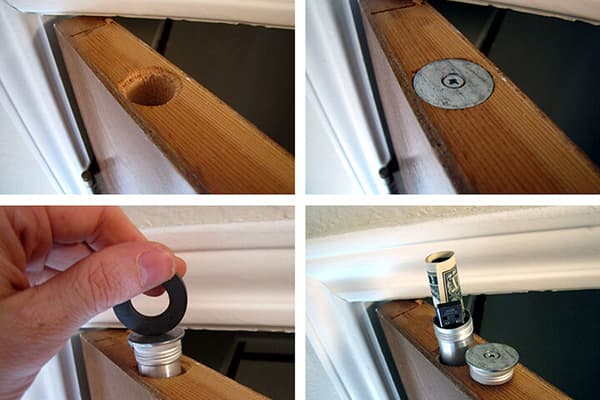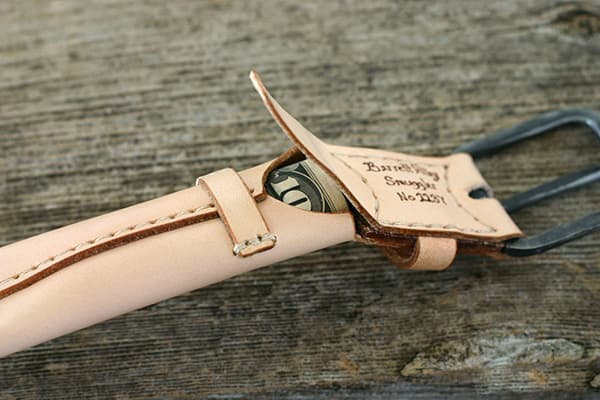Where is the best place to hide money at home or while traveling?
In our age of plastic cards and electronic transfers, the issue of arranging hiding places for money and jewelry still remains relevant. After all, it is not always prudent to keep absolutely all your savings on a card or bank account (or there is simply no way to put them there). And you can’t put jewelry on the card at all. How to hide money in an apartment so as not to worry about its safety?

How to hide money?
The answer seems simple: securely, so that no one finds it. But reliably – where does that go? It’s no secret that burglars know quite a few of the most popular apartment hiding places among ordinary people, which they will gut first when they find themselves in the home of a family that has gone somewhere else.
On the Internet you can find a lot of advice on setting up reliable secret storages for money, which in fact will turn out to be the easiest finds for thieves. Among them, for example:
- chests of drawers, cabinets, pillows, mattresses, upholstery;
- flush tanks, ventilation, space under the sink, toiletries (shaving foam, bottles of air fresheners, hair spray);
- flower pots;
- laminate, baseboard;
- carpets, sconces, paintings, clocks, mirrors hanging on the walls;
- bookshelves;
- TV, computer, set-top box;
- refrigerator, freezer, containers with bulk products, trash can, oven, microwave.
- obvious hiding places - boxes, DVD cases, safes.
At first glance, with this approach there are practically no places left in the house that attackers would not be able to detect and destroy. But this is only at first glance. After all, in order to hide money or jewelry in an apartment, you need to arrange the hiding place so that it blends organically with the overall interior and does not look like an obvious hiding place. Therefore, you just need to carefully examine the apartment and then think carefully.
If you plan to access the contents of your secret storage frequently, there is no point in setting it up in the most inaccessible place. Constantly moving cabinets, placing a stepladder, or performing some other inconvenient manipulations is, to put it mildly, unwise. But they will certainly be justified if the money is saved for a long time.
Where to hide money in an apartment or house?
So, if you think about it, a hiding place can be organized almost anywhere. The main thing is to make it invisible. For example:
- drill (or make in some other way) a niche for a stack of banknotes on the upper and lower edges of the interior door and seal them on top with suitable veneer or furniture film;
- roll up the money into a tube, secure it inside a hollow curtain rod above the window (a hollow curtain rod for a bathroom curtain can become the same hiding place);
- cavities inside the window sill, shelving, wall, cut out with your own hands, will not be noticeable and obvious;
- an envelope with money can be attached with adhesive tape from below to the bottom of the bottom drawer of the chest of drawers - even if it is opened several times, such a “bookmark” is unlikely to be discovered;
- arrange a false socket on the wall, which will be identical in appearance to the other sockets, but at the same time will be non-working and will hide a niche for bills or other valuables.
- wrap the money in plastic and put it inside the comb, between the top and rubber (with tacks-tooths) parts;
- wrap a bundle of banknotes in plastic and hide it inside the float of the drain tank (usually thieves meticulously check only the bottom of the tank; they are unlikely to think of opening the plastic part), just make sure that the bundle of money is not too heavy, otherwise the correct water drainage mode will be disrupted;
- install a false pipe in the bathroom that will lead “from nowhere to nowhere”, while outwardly creating the impression of a worker, and inside hiding a valuable bundle of money;
- Remove the cactus from the pot, carefully cut out a cavity of the required size inside it, put a plastic roll of bills in there and plant the cactus back in its place. Even if they check the pot, they certainly won’t look for money inside the prickly flower;
- remove the upholstery and remove some of the foam from the sofa or chair. Then make a slot in an inconspicuous area, inside which you can create a niche and hide bills or valuables. The slot will easily close, hiding a cache of banknotes underneath. Then you need to return the remaining foam rubber and upholstery to their place.

If the apartment has suspended ceilings, then a small niche between the ceiling itself and the plasterboard is also suitable for storing money. You just need to carefully get between these layers at the place where the chandelier is attached and leave a “bookmark”. And then seal all the seams back.
The rubber band of the refrigerator, which usually hides the magnets that ensure the door closes tightly, is also quite suitable for storing a small volume of banknotes if you carefully cut it in an inconspicuous place, remove some of the magnets, and then put money in their place. After this, of course, the cut needs to be repaired.
If you have a desk in your house or apartment (almost certainly), you can leave on it several ballpoint pens with bills rolled up inside them. Thieves are unlikely to be lucky in finding money hidden in this way. Of course, this option is suitable if the amount of money is small and the bills themselves are large. Otherwise, a whole mountain of office supplies may arouse suspicion.
Perform a fraudulent maneuver: leave a small part of the money in a safe in a visible place in the apartment. Having found it, thieves will most likely stop searching and leave the apartment along with the safe (they are opened extremely rarely in the apartment itself), deciding that this is all your savings.
Where to hide money on a trip?
We will, of course, talk about the train, because it is here that things and savings are most often left unattended, and the trip takes the longest time.
It all depends on the amount that needs to be transported safely. If it is small, then it is best to attach money to the body in one of these ways:
- place in a resealable bag and secure generously with a good bandage;
- put the bills in the boot of an old nylon stocking (or cut it off from tights) and wrap it around yourself, tying it tightly;
- sew a small pocket for bills under the jeans label;
- sew a pocket on the back of the bra (if a woman is carrying savings) and invest money in it, securely sealing or sewing it up. After all, attackers will first of all look for profit in the cups of a bra, and they will not be stopped by an attempt to resist.
You can also put the money at the very bottom of the luggage bag, and it under the seat on the bottom bunk (in this case, it is better to travel with a travel companion, whom you can leave to look after your things if you need to go away).
A money scam can serve a good purpose on a trip: a pack of counterfeit bills in a cheap wallet. You can put a couple of real small denomination pieces of paper in it so you can take it out, for example, when going for food. Thieves will see where the money was taken from and will “steal” this particular deception.
Perhaps the most effective and safest way to transport a large amount is to issue a money transfer in your name, which is sent to your destination and then withdrawn from the bank upon arrival.
Perhaps, after reading this article, someone will come up with even more ingenious ways to deceive thieves and save their money. The main thing is to make sure that the owner of material assets can, if necessary, get to his stash.



Now all the burglars know where the money is hidden - educational program!
A wonderful educational program for burglars.
burglars break or empty/empty all the cans, bottles and gut everything that can be gutted (clothes, books, pillows) I personally piled everything in the yard, in the grief of it being hard to carry and a pity to throw away